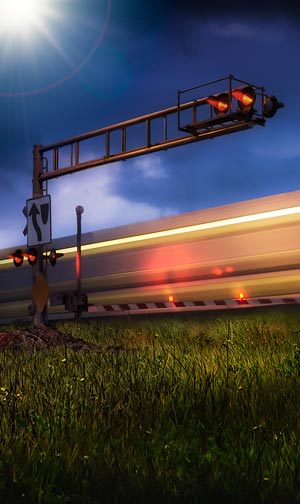Injuries and Stories of Terror in the Wake of North Carolina Amtrak Wreck
(Halifax, North Carolina – March 10, 2015)
Accounts of fear as well as serious injury continue to surface as numerous communities and transportation systems attempt to recover from a collision between Amtrak’s “Carolinian” and a large 13-axle semi-trailer, escorted by, among others, a North Carolina State Highway Patrol Trooper and following an NCDOT-prescribed route, carrying what was described as an “electrical distribution center” – nearly 15 feet longer than half a football field, 16 feet tall and 16 feet wide, and weighing 255,000 pounds, at a signalized CSX railroad grade crossing in Halifax, NC just after noon this past Monday.
Injuries among the 54 passengers and the locomotive engineer of the New York-bound train ranged from severe to moderate to minor, and most were being treated locally at the Halifax Regional Medical Center, while the uninjured, although inconvenienced, were thankful to be alive.
Among the most seriously injured was Delaware resident Mary Kramer, 85, who was in Raleigh, NC looking for a place to live near her daughters, and was returning home when the accident occurred.
She was flown by helicopter to Vidant Medical Center in Greenville, NC, as her injuries were more severe than most of the passengers, and her family were all gathering there to both support her recovery as well as to seek answers as to why the mishap occurred. Of the Halifax Road/CSX crossing, Mary’s son, Raymond Kramer, was justifiably, angrily curious. “There’s nothing in place to stop this?” he asked. “Just a sign with a phone number, that actually either nobody made that call or somebody made that call and nobody answered that call, which one is it?” he continued to query. But answers were few and excuses were abundant.
NCSHP Spokesman Lt. Jeff Gordon said that drivers or their companies, and not state trooper escorts, are responsible for informing railroads along the high/wide/heavy load’s path of their intention to cross tracks along their assigned route.
Ditmeyer, a former Federal Railroad Administration official, added that the CSX crossing in Halifax “is known as a bad geometry crossing” due to the fact that the tracks and highway do not cross at a 90 degree angle.
Time Warner Cable News Reporter Heather Moore said that “The trooper did not notify the train company (CSX) because the truck was never stuck on the tracks, (instead) it was actively trying to navigate the sharp turn with its oversized load.”
The NCDOT-issued permit required the NCSHP trooper escort whenever the load was off the Interstate Highway system. Otherwise, escort was provided by specially-equipped vehicles hired or provided by the trucking company, Guy M. Turner, Inc. of Greensboro, NC.
There were also the thankfully unhurt passengers. Among them was Richmond, VA-bound Duke University student Alexis Pearce, 22, headed for spending spring break with her father, Steve Pearce, who monitored her anxious moments via cell phone as he waited hours for her arrival. “I feel very blessed,” said Alexis of the harrowing experience aboard a train she had taken for safety reasons. Having survived an automobile accident only three weeks earlier, she chose to travel by train and not risk the dangers of highway traffic. Her father reported to WRIC-TV in Richmond, VA that when his daughter called right after the collision “She was traumatized, and shook up, and I could hear someone in the background talking to her and trying to calm her down.”
Connecticut resident Susan Gluckman said that, although the impact of the collision threw her from her seat in the first coach, which derailed but stayed upright, she was not injured. However, she termed the experience to have been “very fast,’ and “very scary.”


